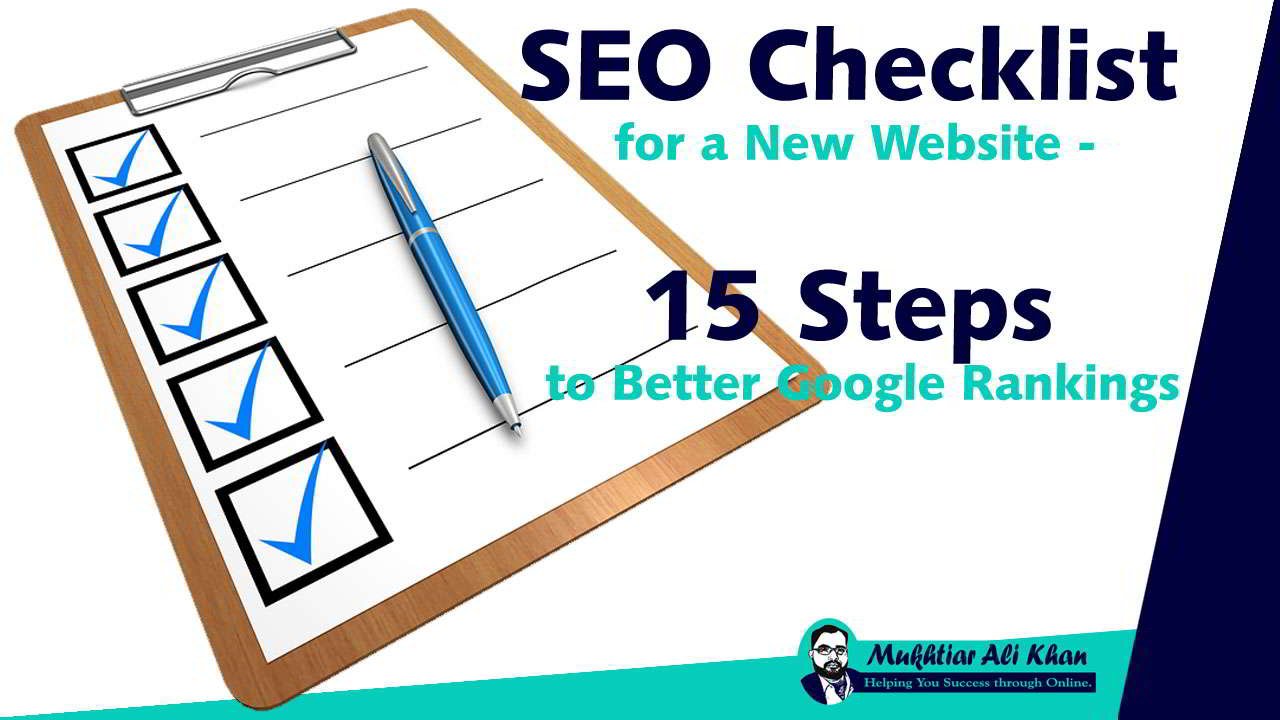Updated August 2023
Do you want higher search results and more traffic to your website? This SEO checklist for new websites accompanies you step by step through all the important processes of successful search engine optimization. A structured approach is particularly crucial when it comes to optimizing a website because the desired effects are mainly the result of long-term and continuous improvements!
With this SEO checklist for new websites, you can start planning and implementing your SEO project today. Before reading this post must watch the below video to know the best SEO Strategies.
- Best SEO Strategies at Khans Tutorials
- Planning & Preparation
- Build a strong team
- Create a keyword list through proper keyword research
- Competitor analysis
- Define Goals & Success Indicators
- Create an Editorial Plan
- Implementation of the SEO strategy
- Technical Optimization
- Content Optimization
- Implement Analytics
- Integrate Social Media
- Create New Content
- Build a Social Community
- Link Building
- Controlling & Measuring Success
- Make Decisions
- Stay Up to Date
- Conclusion – SEO Checklist for New Website
Best SEO Strategies at Khans Tutorials
The individual processes are divided into the preparation and implementation phases so that you get a meaningful orientation, at which point in the project flow you are currently.
Planning & Preparation
Before starting a new business you must have proper planning and preparation to accept all the challenges. That’s why in our SEO Checklist for new websites this point is coming very first.
Build a strong team
The significance of good search engine visibility extends beyond just the marketing or IT department. It has become a strategic necessity for businesses, impacting overall success. Hence, all stakeholders and decision-makers must align their efforts toward this goal.
Whether you’re a sole trader or part of a team, collaboration is key. Sometimes, involving external experts or freelancers for certain aspects of the SEO checklist can provide valuable support in achieving your objectives.
In the first step, check who should support you in your project and try to get the right people on board right from the start:
- marketing & Distribution
- Webmaster, programmer
- IT / Network Admins
- graphic Designer
- Editors, PR
- Board members, department heads
- Product Manager
In the SEO checklist for new websites building your strong team is a very important part of controlling all the necessary tasks which are not easy to complete alone.
Read Also: Website Creation: 7 Vital Checklist Points for Success
Create a keyword list through proper keyword research
Build a solid keyword list by conducting thorough keyword research, an essential step in your SEO checklist. It’s crucial for optimizing your content and boosting search engine visibility effectively. Careful keyword research and the development of topics for later content production are the basis of any search engine optimization.
You can start by writing down the terms and combinations of terms that are close to your industry or product. Working techniques such as brainstorming or mind mapping can also be used to gather initial ideas.
Tools such as Google Keyword Planner or Ubersuggest can be used to expand or complete your keyword list. After creating a list of terms, you should rate them according to the importance of your project. This includes, on the one hand, the search volume but also the competition density.
The less competition for a keyword, the easier it will be for your page to get to the front. At the same time, however, there should be sufficient interest to search for the term.
Now organize your keywords into topic groups by creating so-called keyword clusters. In doing so, your group (for example in an Excel spreadsheet) all the terms that are thematically related to each other and assign them to the main topic.
In this way, you can identify topic units that may be useful for structuring your navigation or categories for a future blog. Finally, you should still determine the search intention for each keyword, i.e. what intent a user is likely to pursue his search query.
For example, you can identify which keywords are appropriate for your sales pages and which ones are best for guidebook content or the FAQ section.
Overview of the individual points:
- Research keywords
- Perform keyword analysis
- Create topic groups
- Mark search intent
Keyword research is the key element in the SEO checklist for new websites to have a good keyword list with you in the ranking.
Read Also: Useful Google Chrome Extensions for Travelers
Competitor analysis
Perform thorough competitor analysis as part of your SEO checklist. Understanding your rivals’ strategies helps identify opportunities and refine your own approach for better search engine rankings and performance.
Part of good preliminary work is knowing your competitors in the SEO checklist for new websites.
Based on your keyword list, you can identify who can be found on the same topics and examine these sites closely.
You may also notice other terms and topics that position your competitors, and which are also of interest to your target audience.
Pay attention to frequently recurring elements. These may be industry standard standards that should also be present on your page.
In the same way, however, it is also possible to recognize possible distinguishing features from the competition, which can later be emphasized in particular.
Overview of the individual points:
- Identify important competitors
- Compare structure, topics, and contents
- To work out standards and differentiation criteria
Define Goals & Success Indicators
Define clear goals and success indicators in your SEO checklist. Establish measurable objectives, like increased organic traffic or higher conversion rates, to track your progress and optimize strategies effectively. Now create a concrete outline plan in which you set your short-term, medium-term, and long-term goals according to this SEO checklist for new websites.
The main thing here is that you have the right goals and realistic expectations. Quick successes are usually the exception in search engine optimization because there is no linear relationship between the individual measures taken and a visible change in the rankings! This means that it can often take several months without noticeable effects until many small individual measures result in an overall result and increase in traffic.
To create measurable criteria, one should, therefore, formulate milestones for important project phases and minimum and maximum goals as reference values when it comes to numbers.
In addition to the sheer number of page views, you should also select success metrics that say something about visitor activity on the site (e.g., hold time, bounce rate, conversions).
Overview of the individual points:
- Defining short-term, medium-term, and long-term goals
- Formulate milestones for important project phases
- Set minimum or maximum targets as reference values
- Select success metrics to measure visitor activity
Create an Editorial Plan
You have already done much of the preparation phase as our SEO checklist for new websites. What is still missing is a theme plan or editorial calendar to organize the creation and dates for publishing new content.
For example, Google Calendar works well for this purpose because you can easily collaborate with other members of the team.
In the theme plan, you determine when new content should be published on which topic and in what form, i.e. whether it is blog posts, white papers, videos, etc. For this, you should also define a suitable production process, which should be completed from the creation of texts and graphics to possible release and correction rounds up to publication.
Overview of the individual points:
- Develop a theme plan
- Set production processes
Implementation of the SEO strategy
You should now have a good overview of what topics should turn on your site, how your competitors represent, and what goals you want to achieve in which period. Everything is ready to start, so you can start implementing it!
Technical Optimization
First, the main technical factors should be checked.
In particular, this means that the site is accessible and indexable to search engine robots, so the page is not programmed in Flash or there are errors in robots.txt. The page architecture/navigation structure should be adapted to allow for flat hierarchies (up to 3 clicks to the searched content). Likewise, Duplicate Content should be avoided and attention should be paid to the correct use of 301 redirects and an existing error page.
Even the fastest possible loading speed and optimal presentation on mobile devices play an important role in the visibility of the search results.
In addition, an XML Sitemap can be created and submitted to Google Search Console to facilitate content indexing.
Overview of the individual points:
- Ensure indexability of the website (e.g. no Flash)
- Check navigation structure and optimize if necessary
- Note Duplicate Content Avoidance
- Correct use of 301 redirects
- 404 Create an error page
- Optimize loading speed
- Optimization for mobile devices
- Create robots.txt
- Create XML Sitemap
Content Optimization
Enhance your content’s impact with the power of content analysis. Content optimization ensures your material is relevant, engaging, and ranks well in search engines, enhancing your online presence.
Creating and optimizing content is a critical factor in increasing the findability of a website in organic search results. First, check your existing content to see if it needs customization. After that, it is an ongoing process that affects every new subpage. Google especially honors content that is informative, useful, and adds value to your reader.
Above all, make sure that your texts are well-prepared in terms of content, answer as many questions as possible, and adhere to a natural writing style. For structuring, each subpage should contain a single H1 main heading and additional headers labeled H2, H3, etc. Formatting such as bold and italics or bullets with the most important information also belongs to good structuring and facilitates the readability of your texts.
Internal and external links from the texts should provide the reader with further information and help with clear orientation. Therefore, link texts like “click here” should be avoided and replaced by more meaningful phrases. When using images, note that they have an ALT attribute with a brief description of the graphic.
Finally, there should be a title tag and a meta description in the source text on each subpage. These should each be uniquely formulated and should not unnecessarily exceed the maximum character limit Google displays.
Overview of the individual points:
- Ensure high-information content
- Use the H1 heading (only one per subpage)
- Structure texts by subheadings (H2-H4), formatting, and bullet points
- Use internal and external links with descriptive names
- Use ALT attributes in graphics
- Create a Title Tag (approximately 60 characters) and meta Description (approximately 160 characters)
Implement Analytics
A visitor behavior analysis system, such as Google Analytics, enables you to measure your previously set goals.
If it does not already exist, the code should now be installed on the site, and the capture of important visitor events such as conversion and event tracking, as well as internal queries (if any) configured.
Overview of the individual points:
- Install Analytics Code
- Configure conversion & event tracking
- Capture internal searches
Read More: What is a good bounce rate in Google Analytics & How to improve it.
Integrate Social Media
To raise awareness of your content on social media channels such as Facebook, Twitter, LinkedIn, Google+, etc., first, select the platforms relevant to your project or audience and set up your profiles.
In addition, additional social media buttons should be integrated into your website, so that social interactions with your content can be promoted and your readers can share interesting posts more easily with their circle of friends.
Although social signals do not have to have a direct impact on the Google rankings, overall they can increase the visibility of your site and thus have positive effects on the search engine presence.
Overview of the individual points:
- Select relevant social media platforms
- Create accounts and set up profiles
- Integrate social media buttons on the website
Create New Content
Creating content is the most important part of a working SEO strategy.
Stick to your previously created editorial plan and provide your readers with helpful, interesting, and useful information regularly!
These can be published in the form of blog articles, white papers, case studies, FAQs, guidebook content, infographics, videos, ebooks, etc., to build the widest possible range of content on your site.
Overview of the individual points:
- Create new content regularly
- Build interesting and useful content
- Use different formats
Build a Social Community
Also, be aware of your new content regularly by sharing it on social networks!
However, you should not confuse social media channels with free advertising platforms in which you just spread your messages.
Instead, it’s about having a dialogue and building a long-term relationship with your community. This means listening, responding to comments, participating in important groups and forums, and maintaining contacts.
In addition, you should, of course, check your profiles now and then for up-to-date and keep all information up to date.
Overview of the individual points:
- Share new content on social networks
- Build a dialogue with the community
- Keep profile information up to date
Link Building
Links from other sites are a key factor in good rankings, as they are viewed by Google as a kind of positive recommendation for your site.
While in the past the sheer number of backlinks was crucial, nowadays quality is more important than the number of links pointing to your page.
The best strategy is, therefore, to continue to publish regularly high-quality content, which is gladly read and linked!
If you still want to do something to promote yourself, therefore, look out for potential affiliate sites or bloggers who are also involved with your topic, and build collaborations or guest contributions for publication.
Overview of the individual points:
- Research partner sites
- Build cooperations
- To suggest guest contributions
Controlling & Measuring Success
Periodically review your Analytics stats to see how the action is affecting your site’s performance. Which content generates the greatest response in the form of page access, hold times, bounce rate, etc.? With the SISTRIX Toolbox, you can also track the time evolution of your Google presence based on the visibility index.
Create a clear report with relevant performance indicators (KPIs) to record the statistics and discuss with other team members if the common goals have been achieved. Also periodically check for broken links on your website or error messages in the Google Search Console.
Overview of the individual points:
- Create reports on relevant KPIs
- Observe the development of visibility
- Broken links and error messages monitor
Make Decisions
Numbers and statistics are of no use if no conclusions are drawn from the data collected and the decisions you made. Therefore, look for contexts that can be used to derive consequences for further action, and adjust your tactics if necessary. Are there topics that are unexpectedly more or less interesting than previously thought? Maybe you should revise your editorial plan again!
Do the visitors on your site find their way around or do they repeatedly come up with the same terms in the internal search? In this case, it may be due to misleading navigation, which should once again be to the test.
Overview of the individual points:
- Recognize relationships and draw conclusions
- Make decisions for further action
Stay Up to Date
If everything is going well for you – congratulations! Now have a solid foundation for the success of your website that will help you get more visitors in the long term. In the past few years, a lot has changed in the SEO area as well, because search engines are constantly developing their algorithms and new functions have been added.
To be able to respond to future developments as well as possible, you should, therefore, keep up to date on the subject and regularly track the most important SEO blogs and news portals.
Conclusion – SEO Checklist for New Website
In conclusion, following this comprehensive SEO checklist can make a significant difference in your new website’s Google rankings. Remember that each step, from keyword research to on-page optimization, plays a vital role in boosting your online visibility. By adhering to these 15 straightforward and actionable steps, you’re laying a strong foundation for your website’s success in the digital world.
Should you have any questions or want to share your experiences, please leave your thoughts in the comments below. And don’t forget to spread the knowledge – share this invaluable guide with your friends to help them on their SEO journey too!






